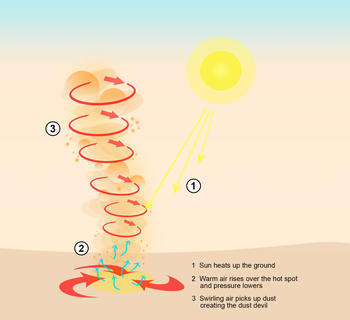…whirling dust devils across the lowlands.
Mars has a very thin atmosphere – only about 1% as dense as Earth’s. Still, atmospheric phenomena like dust devils are widely observed on Mars. During just one orbit, HRSC captured four active dust devils, which are short-lived, localized whirlwinds – much smaller than large-scale dust storms. Dust devils typically form in the afternoon, when the heated Martian surface warms the air above it, causing the air to rise. The rising hot air creates a vertical vortex (whirlwind) that lifts dust and sand into the atmosphere. Through this process dust devils play a significant role in stirring up and distributing dust across the Martian surface.
In the HRSC images, dust devils appear as small bright spots with a trailing pinkish “shadow” (see annotated image). This shadow effect is caused by the dust devil’s fast motion during image capture. The HRSC imaging channels cover the same surface area at slightly different times: the nadir channel views vertically downward, while some channels view slightly forward and others slightly backward. This makes it possible to detect changes in the dust devil’s position and analyze its direction and speed.
On Mars, dust devils can reach speeds of up to 45 m/s and heights of up to 8 kilometers, though they are usually less than 100 meters wide. They are commonly found in broad plains like Arcadia Planitia – similar to their counterparts on Earth, which occur in dry desert landscapes. Despite the differences in atmospheric conditions, Martian and terrestrial dust devils share many similarities. However, those on Mars are often much larger, mainly due to large temperature differences caused by intense daytime heating.
